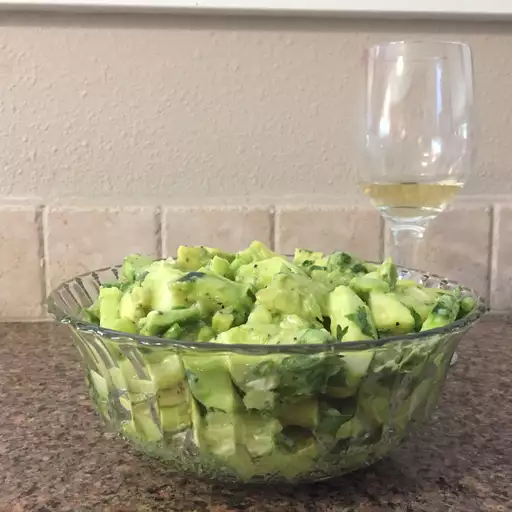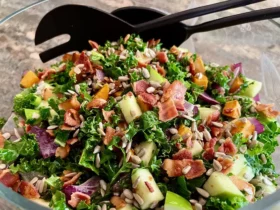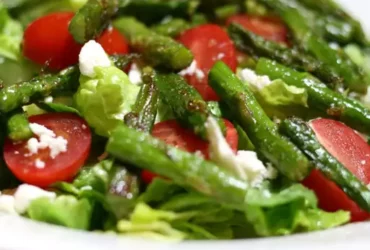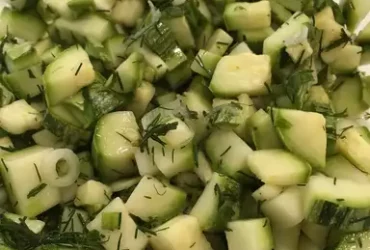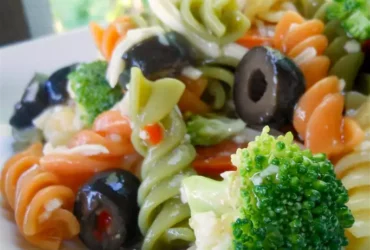Ingredients
Cucumber
Cucumbers are one of the most versatile vegetables (technically a fruit!) when it comes to salads, and they’re particularly well-suited for this Cucumber and Avocado Salad recipe.
The main ingredient in cucumbers is water – about 96% of its composition! They also contain small amounts of sugar, salt, and various minerals like potassium, magnesium, and calcium.
However, what makes cucumbers truly special are their unique properties. They’re low in calories (just 16 per slice!), rich in fiber (about 3 grams per cup), and contain a variety of antioxidants like fisetin, quercetin, and vitamin K.
Cucumbers have been shown to have anti-inflammatory effects, which may help reduce the risk of chronic diseases like heart disease, diabetes, and certain types of cancer. They’re also rich in electrolytes, making them an excellent choice for post-workout snacks or as a refreshing addition to salads.
In this recipe, cucumbers add a refreshing crunch and cool flavor that complements the creamy texture of avocados perfectly. Here are some tips for selecting the best cucumbers:
- Choose English or hothouse cucumbers for their sweeter and less bitter taste.
- Opt for organic cucumbers to avoid pesticide residue and promote sustainable farming practices.
- Select firm, dark green cucumbers with no signs of soft spots or mold.
In terms of preparation, you can slice, chop, or spiralize your cucumbers depending on the desired texture. For this recipe, thinly sliced cucumbers work best to allow them to absorb the dressing and flavors.
1 large cucumber
The ingredients for our refreshing Cucumber and Avocado Salad recipe include:
Main Ingredients
1 large cucumber
This should be a fresh, firm cucumber with no signs of wilting or softness. You can choose from various types, such as English, hothouse, or Kirby cucumbers.
Additional Ingredients
1 ripe but firm avocado
This should be a high-quality avocado with a creamy texture and mild flavor. You can choose from various types, such as Hass, Fuerte, or Bacon avocados.
2 tablespoons olive oil
You can use any neutral-tasting oil for this recipe. Choose an extra-virgin or cold-pressed option for the best flavor and nutritional benefits.
1 tablespoon apple cider vinegar
This adds a tangy, slightly sweet flavor to the salad. You can use white wine vinegar or lemon juice if you prefer.
Salt and pepper, to taste
Add these seasonings according to your personal preference for flavor.
- Garnishes
Chopped fresh herbs (such as parsley, dill, or chives)
Add some chopped fresh herbs to give the salad a pop of color and freshness. Choose one herb that complements the flavors in your dish.
1 tablespoon of fresh dill
When it comes to incorporating fresh herbs like dill into a recipe such as this cucumber and avocado salad, it’s essential to use high-quality ingredients that will elevate the overall flavor and aroma of the dish.
In this case, we’re focusing on using fresh dill, which is an herb known for its bright, citrusy flavor and delicate texture. Fresh dill is typically harvested from the leaves of the dill plant, which are a vibrant green color and have a feathery, lacy appearance.
To use fresh dill in this recipe, we need to first prepare it by washing and drying the leaves thoroughly. This will help remove any dirt or bacteria that may be present on the surface of the herbs and ensure they add flavor to the salad rather than any unwanted impurities.
Once our fresh dill is clean and dry, we can proceed with measuring out the required amount for this recipe – 1 tablespoon. When using fresh herbs like dill, it’s generally recommended to use a gentle hand when measuring, as over-handling can cause the delicate leaves to tear or become bruised.
It’s worth noting that when substituting chopped fresh dill with dried dill weed or dill seed, we may need to adjust the amount used in the recipe. Dried herbs are typically more concentrated than their fresh counterparts, so less is often needed to achieve the same flavor profile.
In this specific recipe for cucumber and avocado salad, we’ll be incorporating the fresh dill into a simple vinaigrette that’s mixed with olive oil, lemon juice, salt, and pepper. The bright, citrusy flavor of the dill will complement the cool, creamy texture of the avocado and the refreshing crunch of the cucumbers perfectly.
Salt to taste
The ingredient “Salt to taste” refers to the use of salt as a seasoning agent in the Cucumber and Avocado Salad Recipe. Salt serves multiple purposes in this recipe, including enhancing flavor, controlling bacteria growth, and balancing sweetness.
Salt is typically added towards the end of preparation, just before serving, so that each person can adjust the amount according to their taste preferences. This allows individuals to customize the level of saltiness in their salad. In general, a pinch or a small amount is sufficient, but some people may prefer more or less.
Salt comes in various forms, including table salt, kosher salt, sea salt, and Himalayan pink salt. Each type has a unique texture and flavor profile, but they all serve the same basic purpose of enhancing taste and preserving food. When choosing a salt for this recipe, consider personal preference or the desired texture and flavor.
Here are some options to use as a guide when determining the amount of salt to add:
- Salt ratio: A common guideline is to use about 1/4 teaspoon of salt per pound of produce. Based on this, for two large cucumbers and one avocado, a pinch (about 1/8 teaspoon) should be sufficient.
- Salt alternatives: Some people may prefer using other seasonings instead of salt or in combination with it. Options include lemon juice, vinegar, herbs like dill or parsley, or spices such as cumin or paprika.
In summary, “Salt to taste” is an instruction that encourages users to adjust the amount of salt according to their preferences while preparing the Cucumber and Avocado Salad Recipe. The right balance will enhance the flavors and textures in the dish.
Avocado
The avocado is a key ingredient in many recipes, including salads, guacamole, and smoothies. It’s a nutrient-dense food that’s rich in healthy fats, fiber, and various essential vitamins and minerals.
Avocados are a type of fruit that grows on avocado trees, primarily found in tropical and subtropical regions. They’re a popular ingredient in many cuisines, particularly in Mexican, Spanish, and American cooking.
When choosing an avocado for your salad, look for one that’s slightly soft to the touch but still firm enough to hold its shape. A ripe avocado will typically have a slight give when pressed, and its skin may be slightly darker or more vibrant than an unripe one.
There are several types of avocados available in different regions, including:
- Hass Avocado
- Fuerte Avocado
- Rhino Avocado
- Pinkerton Avocado
- Camarillo Avocado
- Winter Mexican Avocado
The nutritional benefits of avocados include:
- Rich in monounsaturated fats, which can help lower cholesterol levels and improve heart health
- Good source of dietary fiber, which can aid digestion and promote satiety
- Rich in various essential vitamins and minerals, including potassium, vitamin C, and vitamin E
- May have anti-inflammatory properties and support overall health
Avocados pair well with a variety of ingredients, including cucumbers, onions, tomatoes, bell peppers, cilantro, and lime juice. In the context of your cucumber and avocado salad recipe, you can combine sliced avocados with diced cucumbers, red onions, and fresh cilantro for a refreshing and healthy snack or side dish.
1 ripe avocado, diced
The star ingredient of our refreshing Cucumber and Avocado Salad recipe is a ripe avocado. To choose the perfect one, look for an avocado that yields to pressure around the stem but still feels slightly firm.
Select avocados with a slight give in the skin near the stem, as this indicates ripeness. However, be cautious not to squeeze too hard, as you can bruise the fruit and cause it to spoil quickly.
Once you’ve chosen your avocado, wash it gently under cool running water to remove any dirt or bacteria from the skin.
Next, slice the avocado in half lengthwise around its pit. Then, twist the two halves in opposite directions to release the pit. Avoid using a hammer or other heavy object, as this can cause the pit to shatter and make a mess.
Use a spoon to carefully scoop out the pit from one of the avocado halves. You should be left with a smooth, creamy surface.
Now that you have your avocado halved and pitted, use a sharp knife or a specialized avocado slicer to cut it into desired pieces. For our salad, aim for small to medium-sized dices that will distribute evenly throughout the dish.
The goal is to create uniform cubes of avocado without exposing too much surface area. You want them to retain their creamy texture and flavor while still fitting neatly onto each serving spoon.
Instructions
Mixing the Salad
To mix the salad for this Cucumber and Avocado Salad Recipe, follow these steps carefully to ensure that all the ingredients are well combined and visually appealing.
First, in a large mixing bowl, combine 1/2 cup of diced fresh cucumber and 1/2 cup of diced ripe avocado. These two main ingredients will form the base of your salad.
Add 1 tablespoon of freshly squeezed lemon juice to help prevent browning of the avocado and add a burst of citrus flavor to the salad.
Mix gently but thoroughly, using a fork or spoon, to distribute the lemon juice evenly throughout the cucumber and avocado mixture.
Next, sprinkle 1/4 cup of crumbled feta cheese over the top of the cucumber-avocado mixture. The salty flavor of the feta will complement the freshness of the cucumber and avocado nicely.
Carefully fold the feta cheese into the salad using a gentle turning motion with your fork or spoon, being careful not to break up the large chunks of cheese.
Now it’s time to add some fresh herbs to give the salad a bright and refreshing flavor. Sprinkle 1/4 cup of chopped fresh parsley over the top of the salad, followed by an additional 1 tablespoon of freshly squeezed lemon juice.
Mix the salad again gently but thoroughly, being sure to distribute the parsley and lemon juice evenly throughout the mixture.
Finally, taste the salad and adjust the seasoning as needed. You can add more lemon juice, salt, or pepper to suit your personal taste preferences.
The Cucumber and Avocado Salad is now ready to be served. It’s a light and refreshing side dish that’s perfect for hot summer days or as a topping for grilled meats or fish.
Peel and thinly slice the cucumber
- To prepare the cucumber for the salad, start by selecting a fresh and crisp cucumber from the refrigerator or produce stand.
- Rinse the cucumber under cold running water to remove any dirt or bacteria that may be present on its surface.
- Gently scrub the cucumber with a soft vegetable brush to remove any stubborn impurities.
- Pat the cucumber dry with paper towels or a clean kitchen towel to remove excess moisture and prevent it from becoming too slippery during slicing.
- Place the cucumber on a flat cutting board and locate its stem end, which is usually slightly indented.
- Lay the cucumber down on its side, making sure it is stable and secure on the cutting board.
- Using a sharp vegetable peeler or a serrated knife, begin to peel the cucumber from top to bottom, starting at one end of the cucumber and working your way down towards the stem end.
- Continue peeling the cucumber until you have removed all of its skin, taking care not to press too hard and damage the delicate flesh underneath.
- Once peeled, place the cucumber on a separate cutting board or plate for slicing.
- Using a sharp knife, carefully slice the cucumber into thin lines or strips, depending on your desired thickness and salad composition.
- You can either use a mandoline or a sharp chef’s knife to achieve uniform and precise slices.
- Slice the cucumber as thinly as possible without cutting it too finely, which may result in excess water loss during the cooking process.
In a separate bowl, mash the avocado
- To create this refreshing Cucumber and Avocado Salad, it’s essential to have the ingredients ready and to follow the steps carefully.
- The first step in preparing the salad is to peel, de-seed and chop the cucumbers into bite-sized pieces. This can be done using a sharp knife on a cutting board.
- For this recipe, you will need 2-3 cucumbers depending on their size. Wash them thoroughly before chopping to ensure they are clean.
- Once the cucumbers have been chopped, transfer them to a large bowl and set aside.
- In a separate bowl, mash the avocado using a fork until it reaches your desired consistency. Some people prefer their avocados mashed completely while others like them to retain some texture. The choice is yours!
Here’s how you can mash the avocado:
- Pierce the skin of the avocado with a sharp knife, making sure not to cut too deeply and damage the surrounding flesh.
- Gently twist the two halves in opposite directions until the fruit splits open along its natural seam.
- Scoop out the pit or stone from one half, taking care not to damage any of the delicate green flesh nearby.
- Place the other half on top, skin down. Using a fork, gently press the tines into the avocado’s flesh and pull them upwards, tearing it apart into chunks that are about 1-2 inches square in size.
Continue to mash the avocado until you have achieved your desired consistency, making sure to scrape out any remaining chunks from the sides of the bowl. This process should take around a minute or two depending on how much effort you put into it.
Combine the sliced cucumber and mashed avocado in a salad bowl
To create a refreshing and healthy Cucumber and Avocado Salad, follow these steps:
Step 1: Prepare the Ingredients
- Wash the cucumber thoroughly under cold running water to remove any dirt or impurities.
- Pat the cucumber dry with a clean kitchen towel to prevent excess moisture from affecting the salad’s texture and flavor.
- Cut the cucumber into thin slices using a sharp knife. The ideal thickness is about 1/4 inch (6 mm) for optimal crunch.
Step 2: Prepare the Avocado
- Cut the avocado in half lengthwise and remove the pit.
- Scoop out the flesh of the avocado into a bowl using a spoon or a specialized avocado scoop.
- Mash the avocado with a fork until it reaches your desired consistency. Some people prefer their mashed avocado smooth, while others like it chunky.
Step 3: Combine the Sliced Cucumber and Mashed Avocado
- Place the sliced cucumber in a salad bowl or container.
- Add the mashed avocado on top of the sliced cucumber.
- Gently fold the mashed avocado into the sliced cucumber using a spoon or spatula, ensuring an even distribution of both ingredients.
Step 4: Season and Serve
- Sprinkle salt to taste over the salad. You can use a pinch of Himalayan pink salt for added flavor and nutritional benefits.
- Add any other desired seasonings, such as lemon juice or zest, chopped herbs (like parsley or cilantro), or crumbled cheese (like feta).
- Serve the salad immediately and enjoy the refreshing combination of cucumber and avocado!
Season with salt to taste
To season with salt to taste in the context of a Cucumber and Avocado Salad Recipe, it’s essential to understand the role salt plays in enhancing flavors.
Salt enhances flavor by balancing sweetness and acidity, adding depth, and bringing out the natural flavors of ingredients. When seasoning with salt in this recipe, start by adding a small amount to the salad and mix well.
Taste the salad as you go along, adding more salt in increments until it reaches your desired level of saltiness. You can also season with salt at different stages of preparation – for example, during or after slicing the cucumber or mixing the avocado with lemon juice and herbs.
It’s worth noting that when working with ingredients like cucumber, which has a natural flavor profile that’s often described as neutral, salt can play an even more critical role in elevating the dish. A sprinkle of maldon sea salt, for instance, can add a touch of savory goodness and a burst of umami flavor to the salad.
In terms of how much salt to add, it ultimately depends on your personal taste preferences. If you’re aiming for a lighter seasoning, start with a small pinch of salt – about 1/4 teaspoon per serving. For a more pronounced flavor, increase the amount accordingly.
Remember that using high-quality salt can make all the difference in enhancing the flavors of your Cucumber and Avocado Salad Recipe. Experiment with different types of salt, like fleur de sel or Kosher salt, to find the one that suits your taste buds best.
The key is to season with salt judiciously and mindfully, paying attention to how each addition affects the overall balance of flavors in your salad. By doing so, you’ll be able to unlock the full potential of this refreshing recipe and create a dish that truly delights the senses.
Nutritional Benefits
Benefits of Cucumber
Cucumbers are one of the most widely consumed vegetables globally, and for good reason! They offer an array of nutritional benefits that make them a great addition to any meal.
Here are some key nutritional benefits of cucumbers:
- Vitamins and Minerals: Cucumbers are an excellent source of vitamins K, B, and C. They also contain minerals like potassium, magnesium, and manganese.
- Hydration: Cucumbers consist of about 96% water, making them a great snack for hot summer days or any time you need to stay hydrated.
- Lowers Blood Pressure: The potassium content in cucumbers helps balance out the sodium levels in your body, which can lower blood pressure and reduce the risk of heart disease.
- Anti-Inflammatory Properties: Cucumbers contain anti-inflammatory compounds called fisetin, which may help alleviate symptoms associated with conditions like arthritis.
- Aids Digestion: Cucumbers are high in dietary fiber, which can help regulate bowel movements and prevent constipation.
- Supports Healthy Skin: The antioxidants and vitamins in cucumbers may help protect your skin from damage caused by free radicals, promoting a healthy glow.
Cucumbers are also an excellent addition to any salad, as they add a refreshing crunch and flavor. In the context of our Cucumber and Avocado Salad Recipe, cucumbers provide a cool and creamy contrast to the rich texture of avocado.
High water content (about 96%) and electrolytes
Cucumbers are an incredibly refreshing and hydrating addition to any salad, thanks to their exceptional high water content, which can range from about 96%!
This makes them one of the most hydrating foods on earth
The benefits of a high water content in cucumbers are numerous. Firstly, they can help to flush out toxins and waste products from the body, promoting optimal digestive health and detoxification processes.
Additionally, their high water content contributes significantly to weight management by helping to control hunger and promote feelings of fullness.
Cucumbers are also an excellent source of several key electrolytes that play a vital role in maintaining proper fluid balance and nerve function within the body:
- Calcium: essential for muscle contraction, nerve function, and bone health
- Potassium: plays a crucial role in heart rhythm, blood pressure regulation, and muscle function
- Sodium: involved in maintaining fluid balance and nerve conduction
- Magnesium: important for muscle relaxation, nerve transmission, and energy production
These electrolytes also contribute to optimal hydration by helping the body regulate its internal environment and maintain proper temperature control.
Rich in vitamin K, potassium, and antioxidants
The Avocado, a nutrient-rich superfood, is a key ingredient in our refreshing Cucumber and Avocado Salad, providing an array of health benefits due to its high content of essential vitamins and minerals.
One of the primary advantages of consuming avocado is its richness in vitamin K. This fat-soluble vitamin plays a crucial role in blood clotting, bone health, and cardiovascular well-being. Vitamin K also supports the development of healthy bones by promoting calcium deposition and reducing the risk of fractures.
Avocados are an excellent source of potassium, a vital mineral that aids in maintaining optimal fluid balance within the body. Potassium helps to regulate blood pressure, prevent muscle cramps, and support healthy nerve function. Inadequate potassium levels can lead to fatigue, weakness, and an increased risk of cardiovascular disease.
The antioxidant properties present in avocado are another significant advantage of incorporating this ingredient into your diet. Antioxidants help neutralize free radicals, which are unstable molecules that cause oxidative stress and contribute to the development of chronic diseases like cancer, atherosclerosis, and neurodegenerative disorders.
The high content of monounsaturated fats in avocado contributes to its overall nutritional value. These healthy fats help lower total cholesterol levels, reduce triglycerides, and improve insulin sensitivity, thereby reducing the risk of heart disease and type 2 diabetes.
Incorporating avocado into your diet can have a range of benefits for overall health and well-being, from supporting bone health and cardiovascular function to promoting healthy digestion and satiety. As part of our Cucumber and Avocado Salad Recipe, this nutrient-rich ingredient pairs perfectly with the refreshing flavor and cooling properties of cucumber.
Benefits of Avocado
- The nutrient-dense Avocado is a delicious addition to salads, providing numerous health benefits when consumed as part of a balanced diet.
- Rich in healthy fats, particularly magnesium, potassium, and fiber, avocados are an excellent source of essential nutrients that support overall well-being.
- The monounsaturated fats present in avocados help lower cholesterol levels, reduce the risk of heart disease, and improve blood lipid profiles.
- Avocados are also an excellent source of various vitamins and minerals, including vitamin C, vitamin E, and folate, which support immune function, antioxidant defenses, and fetal development during pregnancy.
- The high fiber content in avocados promotes digestive health, supports healthy blood sugar levels, and helps maintain a feeling of fullness and satisfaction after meals.
In the context of the Cucumber and Avocado Salad Recipe, the creamy texture and subtle nutty flavor of the avocado complement the refreshing taste of cucumber, creating a delicious and nutritious combination that is perfect for hot summer days or as a light and healthy meal option.
Good source of healthy fats, fiber, and various vitamins
Cucumbers are an excellent addition to the avocado salad due to their impressive nutritional profile, offering numerous health benefits when consumed as part of a balanced diet. One of the key advantages of cucumbers is that they are a good source of healthy fats, which contribute to the overall nutritional value and can aid in weight management.
In addition to being rich in healthy fats, cucumbers also provide significant amounts of dietary fiber, an essential nutrient for maintaining digestive health. Fiber plays a crucial role in promoting satiety, preventing constipation, and supporting healthy blood sugar levels. The soluble fiber found in cucumbers can also help lower cholesterol levels by binding to bile acids and removing them from the body, thereby reducing the risk of heart disease.
Cucumbers are not only rich in healthy fats and fiber but also an excellent source of various vitamins and minerals that contribute to overall well-being. One of the most notable vitamins found in cucumbers is vitamin K, which plays a vital role in blood clotting and bone health. Cucumbers are also a good source of vitamin C, an antioxidant that helps protect cells from damage caused by free radicals, supporting immune function, and promoting healthy skin and hair.
The high water content in cucumbers makes them an excellent choice for hydrating the body, especially during hot summer months. Drinking cucumber juice or snacking on raw cucumbers can help replenish fluids and electrolytes, reducing the risk of dehydration and heat exhaustion. Moreover, the cooling effect of cucumbers can also aid in soothing sunburned skin and reducing inflammation.
When combined with avocados in a salad, the nutritional benefits of cucumbers are enhanced even further. The creamy texture of avocado provides an additional source of healthy fats, while its rich antioxidant profile complements the vitamin C content found in cucumbers. Together, these two ingredients create a powerful combination that supports overall health and well-being.
In conclusion, cucumbers are a nutrient-dense food that offers numerous health benefits when consumed as part of a balanced diet. Whether enjoyed raw or cooked, cucumbers can be incorporated into various recipes to provide an added boost of healthy fats, fiber, and vitamins, supporting overall health and well-being.
May help lower cholesterol levels
The nutritional benefits of this Cucumber and Avocado Salad Recipe are numerous, making it an excellent choice for those looking to incorporate more health-promoting foods into their diet.
One of the key Nutritional Benefits of this salad is its ability to help lower cholesterol levels. The monounsaturated fats present in the avocado can actually increase levels of high-density lipoprotein (HDL) or “good” cholesterol, while reducing levels of low-density lipoprotein (LDL) or “bad” cholesterol.
This effect can be attributed to the omega-3 fatty acids found in avocados, which have been shown to improve lipid profiles by increasing HDL and reducing LDL levels.
The combination of cucumber and avocado also provides a boost of fiber-rich nutrients that help lower total cholesterol levels. Cucumbers are a good source of soluble fiber, which dissolves in water and forms a gel-like substance in the digestive tract, helping to slow down the digestion of cholesterol.
The fiber content of this salad can also contribute to weight management by promoting feelings of fullness and reducing hunger. Additionally, the antioxidants present in cucumber and avocado may help reduce inflammation and improve cardiovascular health, further supporting the overall benefits of this salad.
- Best Lusha Alternatives for 2025 - April 22, 2025
- Best Overloop Alternatives for 2025 - April 22, 2025
- Best 6sense Alternatives for 2025 - April 22, 2025

